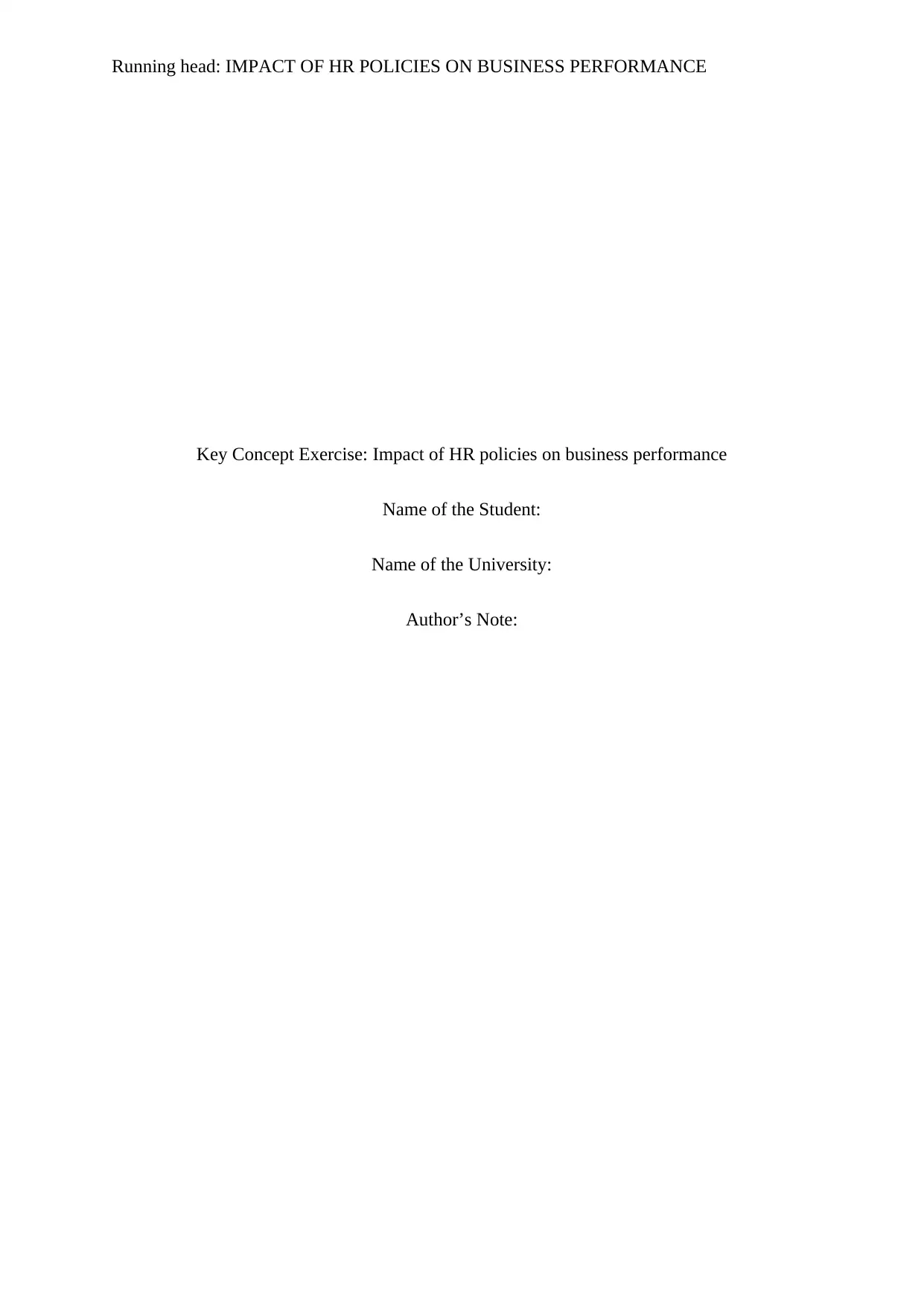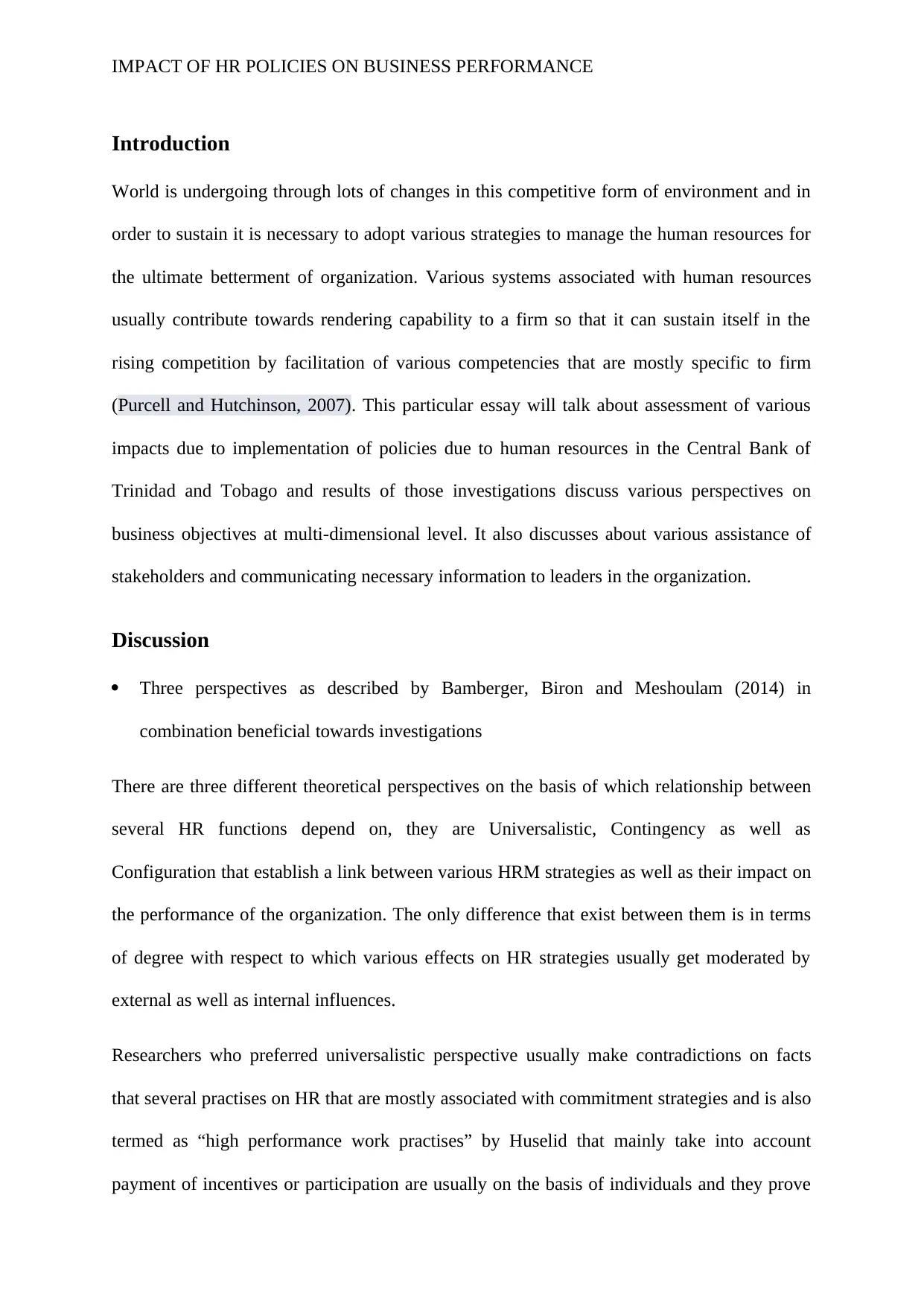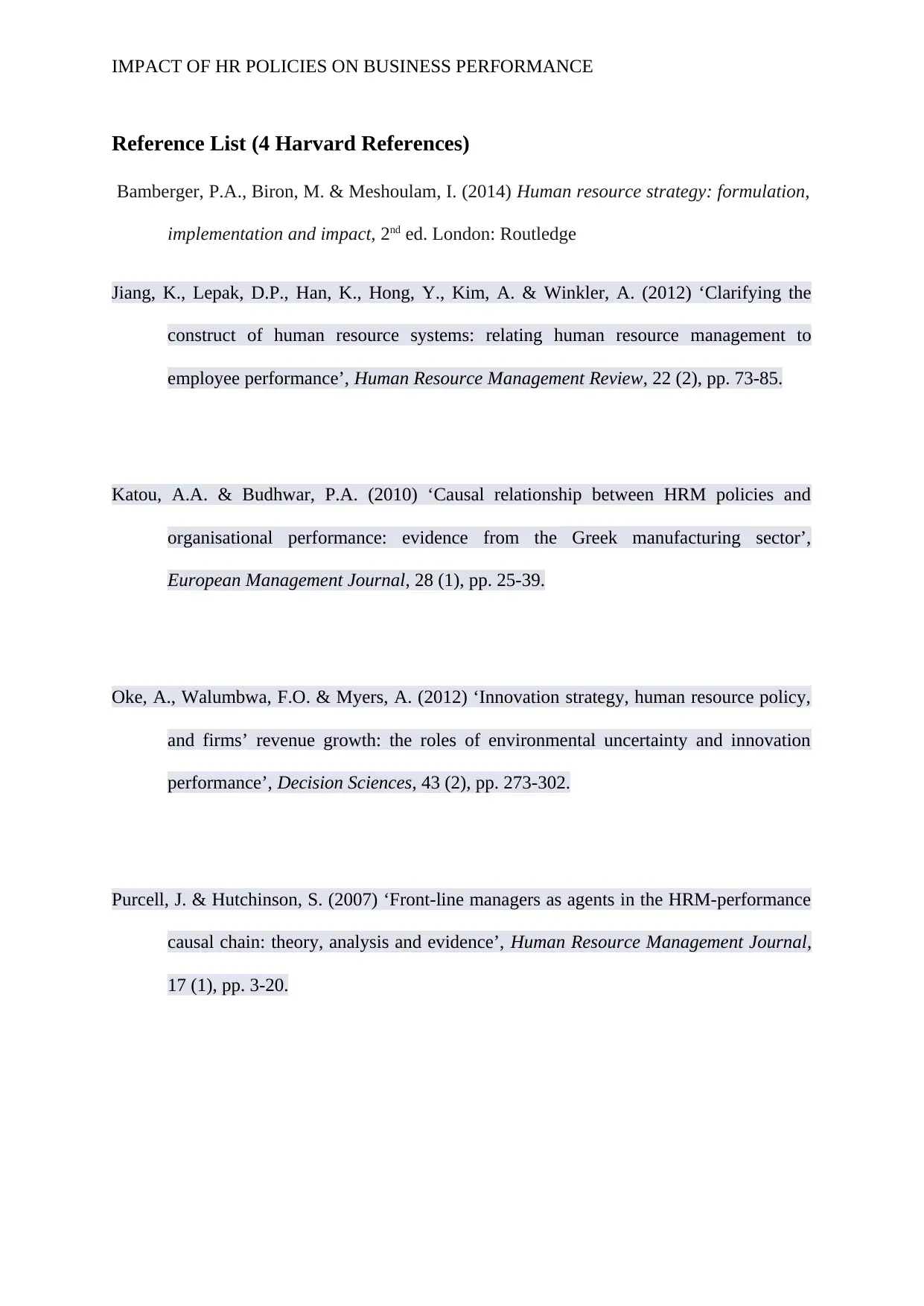Assessing the Impact of HR Policies on Business Performance: Report
VerifiedAdded on 2022/11/14
|7
|1349
|310
Report
AI Summary
This report examines the impact of Human Resource (HR) policies on business performance, focusing on the Central Bank of Trinidad and Tobago. It begins with an introduction that highlights the importance of HR strategies in a competitive environment and their contribution to organizational sustainability. The report then delves into a discussion of three theoretical perspectives—Universalistic, Contingency, and Configuration—as described by Bamberger, Biron, and Meshoulam (2014), to assess the relationship between HR functions and organizational performance. The contingency approach is deemed most useful for the Central Bank. The report then considers the bank's multi-dimensional business objectives, including maintaining monetary stability, issuing currency, and supporting other financial institutions, highlighting unusual aspects like accountability and stakeholder management. The report emphasizes the importance of stakeholder involvement in reframing HRM policies and communicating findings to organizational leaders. The conclusion reiterates the significance of HR policies in employee motivation and overall organizational achievement. The report uses four Harvard references to support its arguments.

Running head: IMPACT OF HR POLICIES ON BUSINESS PERFORMANCE
Key Concept Exercise: Impact of HR policies on business performance
Name of the Student:
Name of the University:
Author’s Note:
Key Concept Exercise: Impact of HR policies on business performance
Name of the Student:
Name of the University:
Author’s Note:
Paraphrase This Document
Need a fresh take? Get an instant paraphrase of this document with our AI Paraphraser

IMPACT OF HR POLICIES ON BUSINESS PERFORMANCE
Table of Contents
Introduction................................................................................................................................3
Discussion..................................................................................................................................3
Conclusion..................................................................................................................................6
Reference List (4 Harvard References)......................................................................................7
Table of Contents
Introduction................................................................................................................................3
Discussion..................................................................................................................................3
Conclusion..................................................................................................................................6
Reference List (4 Harvard References)......................................................................................7

IMPACT OF HR POLICIES ON BUSINESS PERFORMANCE
Introduction
World is undergoing through lots of changes in this competitive form of environment and in
order to sustain it is necessary to adopt various strategies to manage the human resources for
the ultimate betterment of organization. Various systems associated with human resources
usually contribute towards rendering capability to a firm so that it can sustain itself in the
rising competition by facilitation of various competencies that are mostly specific to firm
(Purcell and Hutchinson, 2007). This particular essay will talk about assessment of various
impacts due to implementation of policies due to human resources in the Central Bank of
Trinidad and Tobago and results of those investigations discuss various perspectives on
business objectives at multi-dimensional level. It also discusses about various assistance of
stakeholders and communicating necessary information to leaders in the organization.
Discussion
Three perspectives as described by Bamberger, Biron and Meshoulam (2014) in
combination beneficial towards investigations
There are three different theoretical perspectives on the basis of which relationship between
several HR functions depend on, they are Universalistic, Contingency as well as
Configuration that establish a link between various HRM strategies as well as their impact on
the performance of the organization. The only difference that exist between them is in terms
of degree with respect to which various effects on HR strategies usually get moderated by
external as well as internal influences.
Researchers who preferred universalistic perspective usually make contradictions on facts
that several practises on HR that are mostly associated with commitment strategies and is also
termed as “high performance work practises” by Huselid that mainly take into account
payment of incentives or participation are usually on the basis of individuals and they prove
Introduction
World is undergoing through lots of changes in this competitive form of environment and in
order to sustain it is necessary to adopt various strategies to manage the human resources for
the ultimate betterment of organization. Various systems associated with human resources
usually contribute towards rendering capability to a firm so that it can sustain itself in the
rising competition by facilitation of various competencies that are mostly specific to firm
(Purcell and Hutchinson, 2007). This particular essay will talk about assessment of various
impacts due to implementation of policies due to human resources in the Central Bank of
Trinidad and Tobago and results of those investigations discuss various perspectives on
business objectives at multi-dimensional level. It also discusses about various assistance of
stakeholders and communicating necessary information to leaders in the organization.
Discussion
Three perspectives as described by Bamberger, Biron and Meshoulam (2014) in
combination beneficial towards investigations
There are three different theoretical perspectives on the basis of which relationship between
several HR functions depend on, they are Universalistic, Contingency as well as
Configuration that establish a link between various HRM strategies as well as their impact on
the performance of the organization. The only difference that exist between them is in terms
of degree with respect to which various effects on HR strategies usually get moderated by
external as well as internal influences.
Researchers who preferred universalistic perspective usually make contradictions on facts
that several practises on HR that are mostly associated with commitment strategies and is also
termed as “high performance work practises” by Huselid that mainly take into account
payment of incentives or participation are usually on the basis of individuals and they prove
⊘ This is a preview!⊘
Do you want full access?
Subscribe today to unlock all pages.

Trusted by 1+ million students worldwide

IMPACT OF HR POLICIES ON BUSINESS PERFORMANCE
to be better than that of practises at comparative level that are commonly associated with
other strategies of human resources, they have double effect on the performance of
organizations.
In contradiction to contingency perspectives, certain researchers also take the path of
contingency perspective, demanding the fact that various assumptions that usually underlie
the performance links associated with HR strategies are only under the application being
associated under conditions that mostly fit with external strategies. Strategy towards
management of human resources is taken into account through interactive processes and they
usually do not abide by any reactive or manners in specific direction (Bamberger, Biron and
Meshoulam, 2014). Researchers who usually support contingency perspective usually claim
that various positive as well significant impacts on performances of firm generally align with
strategies of overall business of the organization. Other categories in association with
moderating factors that have been incorporated in models of contingency are factors in
organization for example technologies, structure or size as well as various factors at
environmental standards like competitive, labour as well as macro-economic contexts.
Configurational approach is basically is basically an assumption that can be associated to
“equifinality” and this actually lays emphasis on systems or patterns of HR practises that are
mostly related to each other.
Among all these perspectives, approach on contingencies is usually preferred in Central Bank
of Trinidad and Tobago as the bank operates in such a manner so that it is able to increase
cash-flow in the economy and through proper involvements new methods and techniques, it
is possible to bring such advancements in financial sector (Jiang et al. 2012).
to be better than that of practises at comparative level that are commonly associated with
other strategies of human resources, they have double effect on the performance of
organizations.
In contradiction to contingency perspectives, certain researchers also take the path of
contingency perspective, demanding the fact that various assumptions that usually underlie
the performance links associated with HR strategies are only under the application being
associated under conditions that mostly fit with external strategies. Strategy towards
management of human resources is taken into account through interactive processes and they
usually do not abide by any reactive or manners in specific direction (Bamberger, Biron and
Meshoulam, 2014). Researchers who usually support contingency perspective usually claim
that various positive as well significant impacts on performances of firm generally align with
strategies of overall business of the organization. Other categories in association with
moderating factors that have been incorporated in models of contingency are factors in
organization for example technologies, structure or size as well as various factors at
environmental standards like competitive, labour as well as macro-economic contexts.
Configurational approach is basically is basically an assumption that can be associated to
“equifinality” and this actually lays emphasis on systems or patterns of HR practises that are
mostly related to each other.
Among all these perspectives, approach on contingencies is usually preferred in Central Bank
of Trinidad and Tobago as the bank operates in such a manner so that it is able to increase
cash-flow in the economy and through proper involvements new methods and techniques, it
is possible to bring such advancements in financial sector (Jiang et al. 2012).
Paraphrase This Document
Need a fresh take? Get an instant paraphrase of this document with our AI Paraphraser

IMPACT OF HR POLICIES ON BUSINESS PERFORMANCE
Review over unusual aspects in the organization such as objectives on multi-dimensional
business
Objectives on multidimensional business organization usually pursues its ideas on multiple
form of dimensions for example market segment, region, product as well as market accounts.
It usually maintains combination of several fall on costs associated with information levels,
dynamic development of market consisting of multiple form of dimensions as well as
managing the new generation consisting of managerial bodies as well as other employees in
the organization in order to establish a shift of paradigm in several forms of an organization.
This is in light of various principles of Central Bank located in Trinidad and Tobago where
the organization has to set objectives in maintaining various responsibilities towards issuing
as well as redeeming currencies, maintaining various stabilities in association with monetary
policies, plays a role of banker that would prove to be a financial support to the government
as well as other banks at commercial levels that play significant roles in keeping values of
Trinidad and Tobago currencies (TT Dollar) (Oke, Walumbwa and Myers, 2012). Certain
unusual aspects arise while maintaining integrity as well as provision of supply of money to
satisfy demands of public such as deficiencies in terms of accountabilities, political issues
that may arise while rendering provision of various resources, inconveniences caused while
delegating responsibilities to each individual in the banking industry, failing in meeting
demands of various stakeholders. In such cases effective policies towards development and
planning of human resources would help to bring positive attitude in the public
Aids of primary stakeholders as well as necessary communicating them to the
organizational leaders
Assistance from the side of stakeholders help to reframe various approaches towards HRM
policies and this helps to understand various conflicts that may rise between companies in
Review over unusual aspects in the organization such as objectives on multi-dimensional
business
Objectives on multidimensional business organization usually pursues its ideas on multiple
form of dimensions for example market segment, region, product as well as market accounts.
It usually maintains combination of several fall on costs associated with information levels,
dynamic development of market consisting of multiple form of dimensions as well as
managing the new generation consisting of managerial bodies as well as other employees in
the organization in order to establish a shift of paradigm in several forms of an organization.
This is in light of various principles of Central Bank located in Trinidad and Tobago where
the organization has to set objectives in maintaining various responsibilities towards issuing
as well as redeeming currencies, maintaining various stabilities in association with monetary
policies, plays a role of banker that would prove to be a financial support to the government
as well as other banks at commercial levels that play significant roles in keeping values of
Trinidad and Tobago currencies (TT Dollar) (Oke, Walumbwa and Myers, 2012). Certain
unusual aspects arise while maintaining integrity as well as provision of supply of money to
satisfy demands of public such as deficiencies in terms of accountabilities, political issues
that may arise while rendering provision of various resources, inconveniences caused while
delegating responsibilities to each individual in the banking industry, failing in meeting
demands of various stakeholders. In such cases effective policies towards development and
planning of human resources would help to bring positive attitude in the public
Aids of primary stakeholders as well as necessary communicating them to the
organizational leaders
Assistance from the side of stakeholders help to reframe various approaches towards HRM
policies and this helps to understand various conflicts that may rise between companies in

IMPACT OF HR POLICIES ON BUSINESS PERFORMANCE
mere antagonism in relation that exist between employees as well as the owners (Katou and
Budhwar, 2010). They help the Central Bank in Trinidad and Tobago as it has been studied
that it helps the banking sectors to understand interests of customers and under the influence
of stakeholders the bank works accordingly. This decision making processes is usually
communicated to the senior authorities in the bank who mentors over operations of bank at
various sectors.
Conclusion
Therefore from the above discussion it can be concluded that adequate involvement of HR
policies help in creation of motivation among various employees in the organization and they
work hard for the development of the entire organization. The successful development of
human resources help in bringing overall achievement of the organization. Various
components of HR policies as well as interrelationships establish synergic impact on HR
systems in predictable manners.
mere antagonism in relation that exist between employees as well as the owners (Katou and
Budhwar, 2010). They help the Central Bank in Trinidad and Tobago as it has been studied
that it helps the banking sectors to understand interests of customers and under the influence
of stakeholders the bank works accordingly. This decision making processes is usually
communicated to the senior authorities in the bank who mentors over operations of bank at
various sectors.
Conclusion
Therefore from the above discussion it can be concluded that adequate involvement of HR
policies help in creation of motivation among various employees in the organization and they
work hard for the development of the entire organization. The successful development of
human resources help in bringing overall achievement of the organization. Various
components of HR policies as well as interrelationships establish synergic impact on HR
systems in predictable manners.
⊘ This is a preview!⊘
Do you want full access?
Subscribe today to unlock all pages.

Trusted by 1+ million students worldwide

IMPACT OF HR POLICIES ON BUSINESS PERFORMANCE
Reference List (4 Harvard References)
Bamberger, P.A., Biron, M. & Meshoulam, I. (2014) Human resource strategy: formulation,
implementation and impact, 2nd ed. London: Routledge
Jiang, K., Lepak, D.P., Han, K., Hong, Y., Kim, A. & Winkler, A. (2012) ‘Clarifying the
construct of human resource systems: relating human resource management to
employee performance’, Human Resource Management Review, 22 (2), pp. 73-85.
Katou, A.A. & Budhwar, P.A. (2010) ‘Causal relationship between HRM policies and
organisational performance: evidence from the Greek manufacturing sector’,
European Management Journal, 28 (1), pp. 25-39.
Oke, A., Walumbwa, F.O. & Myers, A. (2012) ‘Innovation strategy, human resource policy,
and firms’ revenue growth: the roles of environmental uncertainty and innovation
performance’, Decision Sciences, 43 (2), pp. 273-302.
Purcell, J. & Hutchinson, S. (2007) ‘Front-line managers as agents in the HRM-performance
causal chain: theory, analysis and evidence’, Human Resource Management Journal,
17 (1), pp. 3-20.
Reference List (4 Harvard References)
Bamberger, P.A., Biron, M. & Meshoulam, I. (2014) Human resource strategy: formulation,
implementation and impact, 2nd ed. London: Routledge
Jiang, K., Lepak, D.P., Han, K., Hong, Y., Kim, A. & Winkler, A. (2012) ‘Clarifying the
construct of human resource systems: relating human resource management to
employee performance’, Human Resource Management Review, 22 (2), pp. 73-85.
Katou, A.A. & Budhwar, P.A. (2010) ‘Causal relationship between HRM policies and
organisational performance: evidence from the Greek manufacturing sector’,
European Management Journal, 28 (1), pp. 25-39.
Oke, A., Walumbwa, F.O. & Myers, A. (2012) ‘Innovation strategy, human resource policy,
and firms’ revenue growth: the roles of environmental uncertainty and innovation
performance’, Decision Sciences, 43 (2), pp. 273-302.
Purcell, J. & Hutchinson, S. (2007) ‘Front-line managers as agents in the HRM-performance
causal chain: theory, analysis and evidence’, Human Resource Management Journal,
17 (1), pp. 3-20.
1 out of 7
Related Documents
Your All-in-One AI-Powered Toolkit for Academic Success.
+13062052269
info@desklib.com
Available 24*7 on WhatsApp / Email
![[object Object]](/_next/static/media/star-bottom.7253800d.svg)
Unlock your academic potential
Copyright © 2020–2025 A2Z Services. All Rights Reserved. Developed and managed by ZUCOL.





